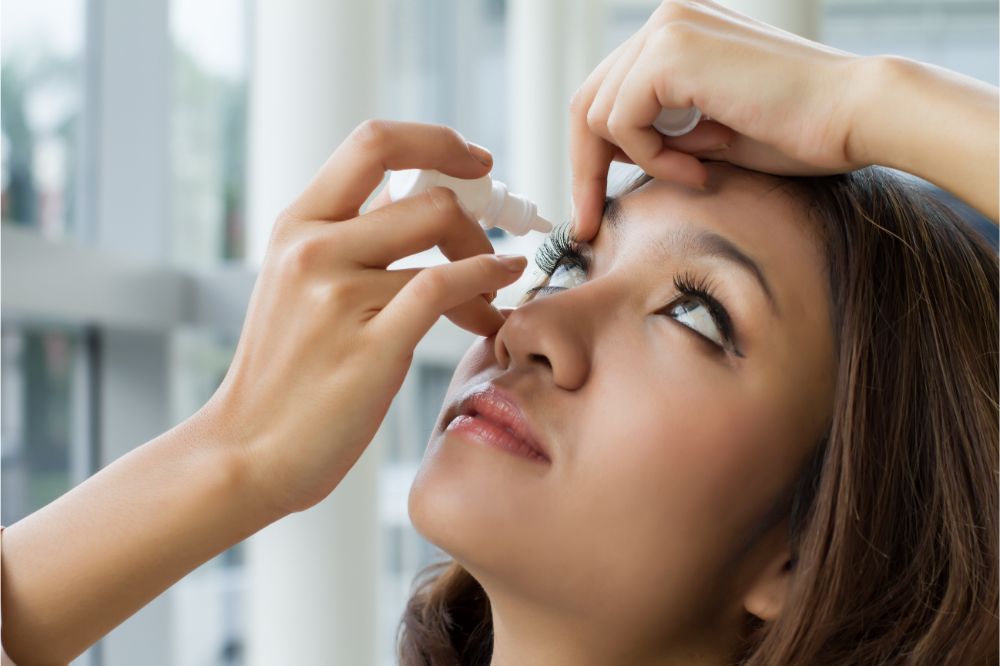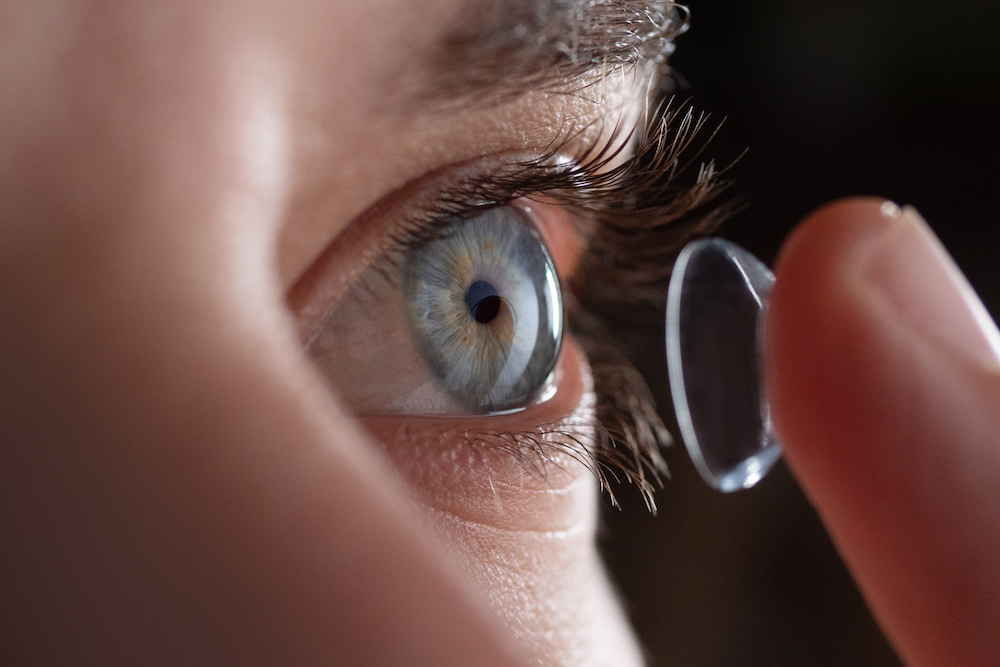Can you use eye drops with contacts? This question is likely one of the most asked by patients needing corrective lenses.
As helpful and versatile as contacts are, they can come with a long list of troublesome effects, like dry eyes, itchy eyes, and red eyes.
To help alleviate these concerns, many wonder whether eye drops are the right choice to keep their eyes comfortable when wearing contacts.
Can You Use Eye Drops With Contacts?
As a contact-wearer with irritated eyes, you will be glad to know that most eye drops are safe to use with contacts.
However, there are a couple of exceptions to make a note of.
It can be best to speak to your optometrist or ophthalmologist to get a recommendation for contact-safe eye drops for severe eye concerns.
Otherwise, let’s explore the different eye drops that are and aren’t okay to use with contact lenses.

Lubricating/Rewetting Eye Drops – Yes
The most popular eye drops that contact wearers use are rewetting or lubricating eye drops.
They’re specifically marketed to contact users but can also be helpful for those who don’t need corrective lenses.
Lubricating eye drops have the primary purpose of rewetting your eye, keeping it fresh and comfortable all day long.
Fortunately, they are entirely safe to use with contact lenses and are often explicitly formulated for them.
Another massive benefit of these eye drops is that they can help remove irritants under your lenses.
For example, if you get dust in your eye, you can use drops to clean out your eyes instead of rubbing your lens and causing surface abrasions to your eyeball.
Vasoconstrictor Eye Drops – No
Another massively common type of eye drop you’ll find in any store is vasoconstrictor eye drops.
These formulations are designed to help alleviate redness in the eye and are used for an assortment of purposes.
When administered, the eye drops shrink your eye’s blood vessels, helping alleviate redness and discomfort.
That said, they are specifically designed for non-contact lens wearers.
This is because vasoconstrictors leave an assortment of deposits on your lenses, which can cause even more eye irritation.
You’ll also find they leave a thin film across the lens surface, making it challenging to see clearly.
Standard glasses are your best option if you have to use vasoconstrictor eye drops throughout the day.
Once your redness is alleviated, you can then wear your contact lenses.
Dry Eye Drops – Yes and No
Standard dry eye drops are safe to use with contact lenses, but opting for lubricating drops could be preferable.
Dry eye drops are mainly designed for non-contact lens wearers.
The liquid has a much thicker consistency. This is because the thick fluid helps coat the eye with ample lubrication to prevent the eyes from drying out.
When wearing contacts, the thickness of the solution can cause your lens to shift while you’re wearing it.
Some formulas may also add a thick film to the outside of the lenses, making it hard to see through them.
That said, it’s not that your eye will be in danger if you use dry eye drops in a pinch; rewetting drops could be preferable.
Medicated Eye Drops – No
When prescribed a specific type of medicine for an eye concern, do not use it with contact lenses.
Your doctor will also likely tell you not to administer the medication with contact lenses.
The medicine must work through the eye’s surface to heal the ailment. When wearing lenses, it will never get past the surface, reducing the efficacy of the treatment.
Also note that it’s best to avoid wearing contact lenses until after your treatment is complete.
The last thing you’d want when healing an eye concern is a lens causing additional irritation.
How To Use Eye Drops With Contact Lenses
If it’s your first time thinking of using contact lenses with eye drops, these steps are sure to help.
You will be able to alleviate dryness and discomfort if you use the correct eye drops for the job.
Step 1: Remove the Lenses
Ideally, the first thing you’ll want to do is take your lenses out of your eye when administering the eye drops.
This step helps ensure the lubrication gets all over your eye for added comfort.
However, if you cannot remove your lenses for any reason, you can always add the solution on top of the lenses.
When doing this, ensure you thoroughly wash your hands before taking your lenses out. You won’t want to put bacteria in your eye or contact lens, causing additional discomfort.
Step 2: Tilt Your Head
When ready to administer the eye drops, tilt your head back to a comfortable position.
Doing this helps ensure the drops get into your eye rather than rolling straight off the surface after they are squeezed out.
You might find it more comfortable to lie down using eye drops until you get the hang of them.
Step 3: Position the Bottle
Next, position the bottle of eye drops directly over your eye, ensuring you keep your eye open to put it in the right spot.
Step 4: Administer the Drops
Now, the most challenging part is administering the eye drops while keeping your eye open.
It can be helpful to hold your eye open using your thumb to pull down your undereye area and your index finger to pull your lid upwards.
Slowly squeeze the bottle without the tip touching your eye, allowing one to two drops to enter your eye.
Once complete, remove your fingers and blink your eye a few times to distribute the formula. Repeat these steps for both eyes, if needed.
Step 5: Reinsert Your Contacts
You can now reinsert your contact lenses with the eye drops coating your eyes.
You should begin to feel a soothing sensation, and your lenses and your eyes will get rehydrated by the drops.

How to Care for Your Contact Lenses
Interestingly, most people who need eye drops for their contact lenses aren’t properly caring for their eyewear.
Old or dirty contact lenses can cause many symptoms you’d get with chronically dry eyes.
Let’s go over some key tips to help you keep your lenses in their best condition.
Tip 1: Always Wash Your Hands
The first thing to remember with contact lenses is that your hands should be spotless before handling them.
Any traces of bacteria can cause eye infections and irritate the underside of the lenses. Over time, the dirtier your contacts are, the more at-risk your eye health becomes.
Tip 2: Always Wash Your Lenses
You should always wash your contact lenses and your hands after wearing them. To wash contacts, put the lens in the center of your clean palm.
Add a couple of drops of your contact lens solution and use your pointer finger to rub the lens in a circle gently.
Add more drops of the solution, flipping the contact lens over and repeating the circular rubbing motion.
Once complete, put the contact lenses in a new solution in your lens holder.
Tip 3: Keep Your Lens Holder Clean
Where you store your contact lenses is of the utmost importance.
It would be best if you always keep your lens holder clean and washed with warm water and mild soap every other day.
After three to four months of daily use, consider replacing the lens holder entirely.
Should I Start Using Eye Drops With My Contacts?
If you are uncomfortable wearing your contacts, you could be asking, “Can you use eye drops with contacts?”
With a safe solution for contacts, your eyes will experience less discomfort over time with these medications.
If any pain or discomfort persists, talk to your healthcare practitioner, as it could be a. problem with the lenses.